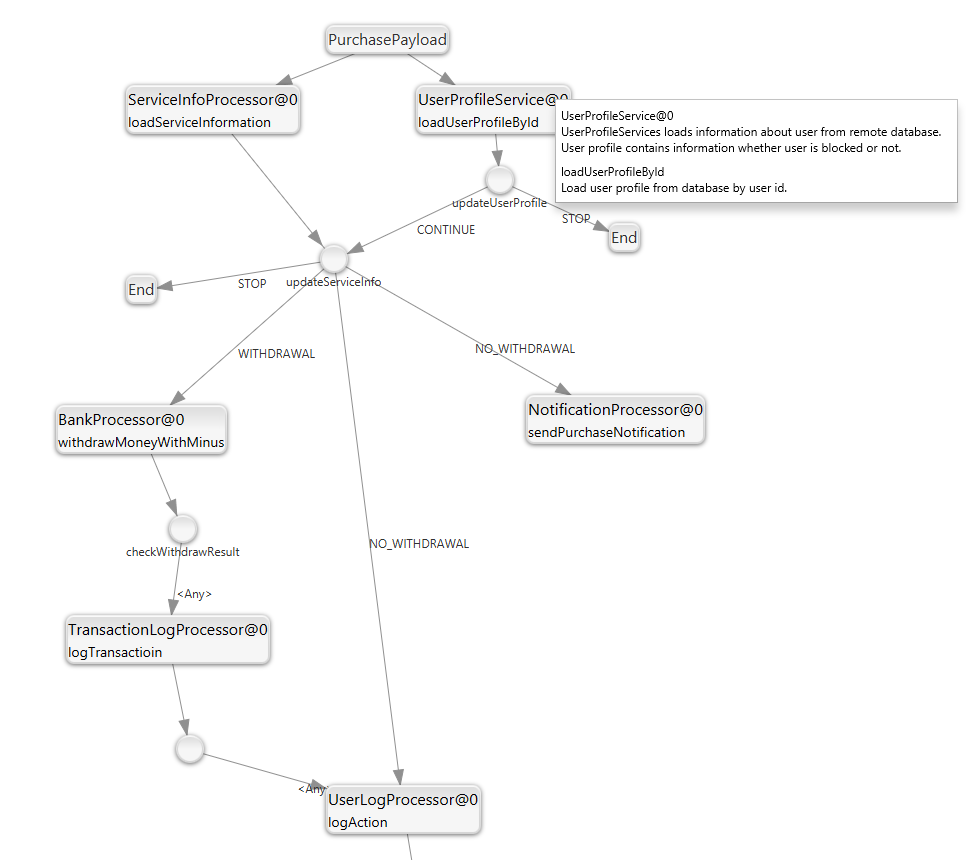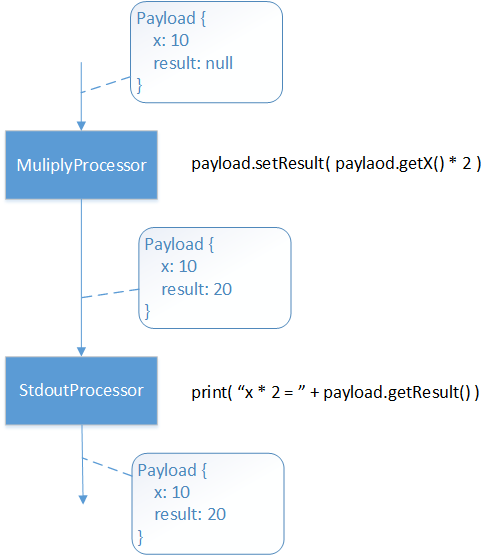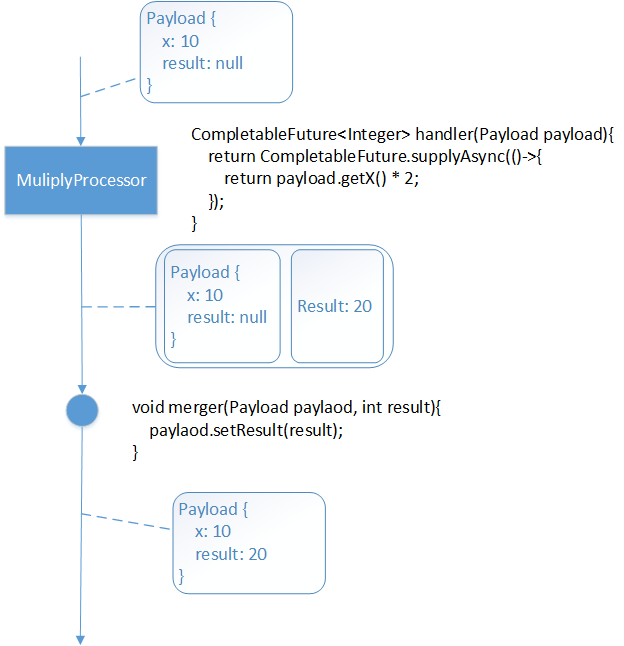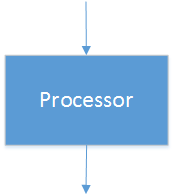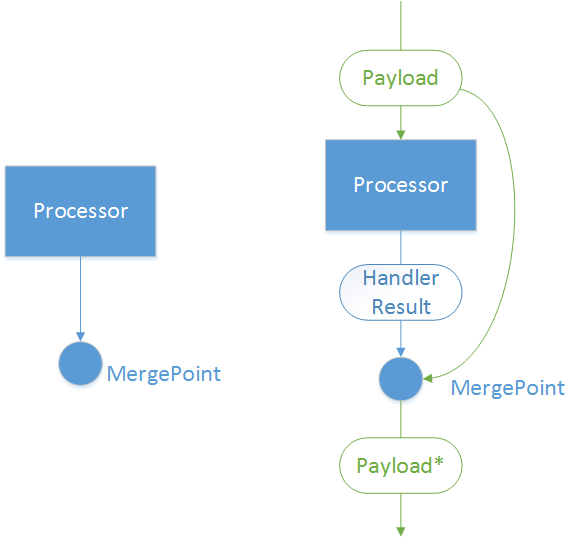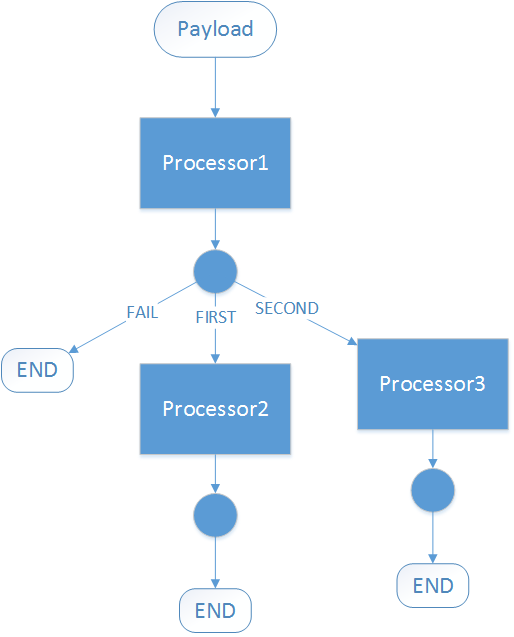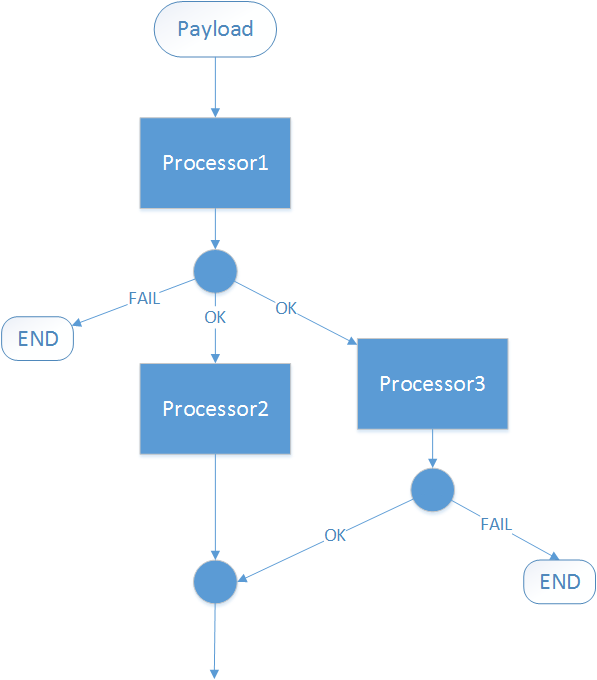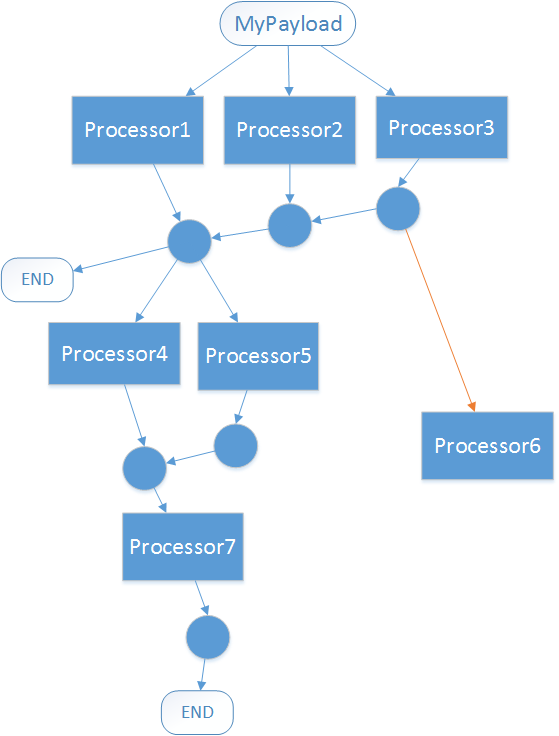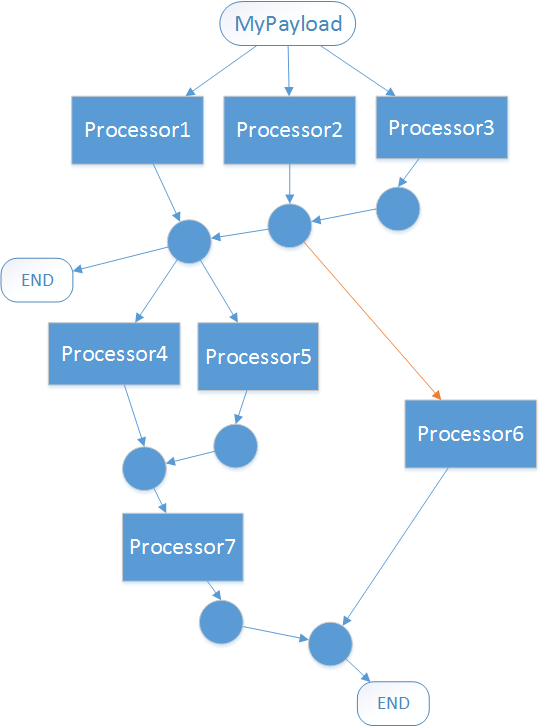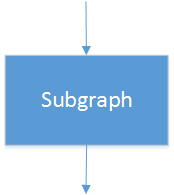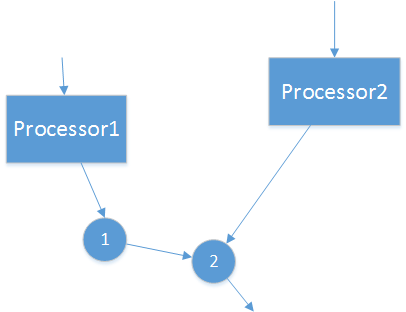CompletableReactor framework makes it easier to create business flows that have concurrently running parts and complex execution branching.
CompletableReactor provides DSL-like builder-style API to describe business flows.
Framework built on top of Fork Join Pool and CompletableFuture API.
CompletableFuture API
with ForkJoinPool
provides ability to write asynchronous code. But sometimes business logic not as straight forward as we would like.
This leads to complex thenApply/thenCompose CompletableFuture chains that hard to read and maintain.
Complex business logic with lots of branching and concurrently executing parts hard to describe using regular coding approach
without proper visualization. And best way to represent that branching is graph with nodes.
CompletableReactor API tries to keep API as simple and possible in same time provides ability to visualize
code as graph of execution flows.
To better understanding of CompletableReactor lets start with simple sequential execution model and then evolve it step by step. This model consists of two base elements: Payload and Processor. Payload is a simple POJO. Processor is active element of model that takes Payload, execute business logic based on that Payload, then modify Payload, store computation result inside this Payload and pass this Payload to the next Processor. All Processors linked in chain one after another. Modification of Payload is optional for Processor.
In given example we have two processors and payload object. Payload consists of two fields: x and result. MultiplyProcessor reads x from payload, multiplies it by 2 store computation result in result field. StdoutProcessor does not modify incoming payload and simply prints result field.
Now lets make our processors work asynchronously. We will split computation logic of processors in two parts. First
one, called handler, will read input data from payload and perform computation. Second one, called merger, will
store computation result inside payload. Handler will be asynchronous function and merger will be synchronous.
Here is an example how to split MultiplyProcessor logic to handler and merger functions: handler will read
argument x from payload, then asynchronously perform multiplication and return CompletableFuture of this operation.
Merger will get result of handler function as an argument and will store it inside payload in result filed.
CompletableFuture<Integer> handle(Payload payload){
return CompletableFuture.supplyAsync(()->{
return payload.getX() * 2;
});
}
void merge(Payload paylaod, int result){
paylaod.setResult(result);
}Visual representation of such computation contains several items:
- Processor bar that represent asynchronous computation of handler function
- MergePoint circle that represent synchronous computation of merger function
- Transition between processor and mergePoint that carries two objects: payload and computation result of handler function.
- Transition that goes into Processor and carries single object - Payload.
- Transition that goes out of MergePoint and carries single object - Payload.
- Paylaod object that goes into Processors, then to MergePoint then out of MergerPoint.
Now we can simplify visual notation and hide implicit Payload and handler function result.
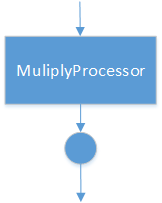
Lets update MergePoint and allow it to have several outgoing transitions. When merger function inside MergePoint
completes merging process it will send Payload through all of outgoing transitions in parallel.
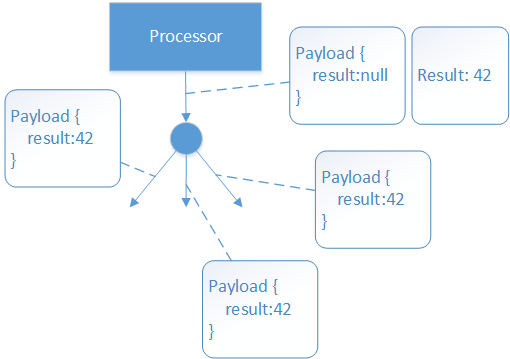
In given example origin Payload and processors Result goes from Processor to MergePoint. Then MergePoint modifies
Payload and puts result inside it. Then MergePoint sends this Payload that contains result 42 to all outgoing
transitions.
Also we need another feature in MergePoint - an ability to join two incoming transitions into single outgoing. When
MergePoint have two incoming transitions: one from Processor that carries Payload with handler Result and another
with simply Payload, MergePoint will chose Result from first transition and will merge it to Payload that it received
from second transition. For activation MergePoint has to wait for both incoming transitions.
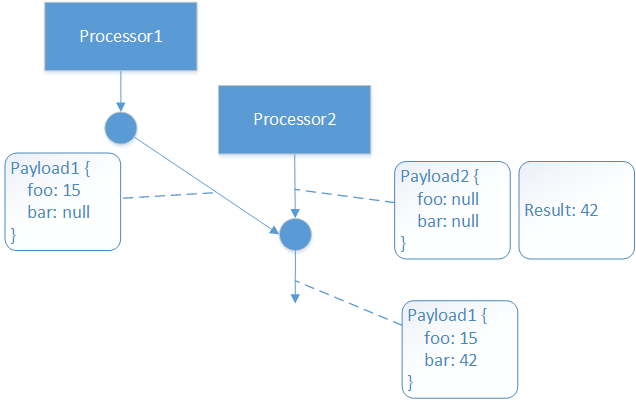 In given illustration there are two incoming transitions into MergePoint. First incoming transition carries Payload2
and computation result of Processor2 - value 42. Second incoming transition carries ony Payload1. MergePoint ignores
Payload2 from first transitions. It takes Payload1 from second transition and takes Result from First transition.
Merges them together by merger function and passes Payload1 to outgoing transition.
In given illustration there are two incoming transitions into MergePoint. First incoming transition carries Payload2
and computation result of Processor2 - value 42. Second incoming transition carries ony Payload1. MergePoint ignores
Payload2 from first transitions. It takes Payload1 from second transition and takes Result from First transition.
Merges them together by merger function and passes Payload1 to outgoing transition.
Now we are ready to make big step to parallel execution.
As an example lets implement purchasing process. Suppose that customer with identifier userId want to buy product
with identifier item. During purchase process we have to reserve money on users account and reserve product in our
storage. BillingService will provide asynchronous method to reserve money. And StorageFacility will provide
asynchronous method to reserve product in the storage. We can require reservation in parallel in both services and
then if both services successfully performed reservation we can return answer to the user which purchase accomplished
successfully.
Plain class Purchase will serve as payload object in our model.
class Purchase{
Long userId;
Long item;
Boolean moneyReserved;
Boolean productReserved;
Boolean result;
}userId and item will identify customer and requested product. moneyReserved and productReserved fields will
keep information about reservation status returned from BillingService and StorageFacility.
Lets visualize execution graph and discuss execution steps in detail.
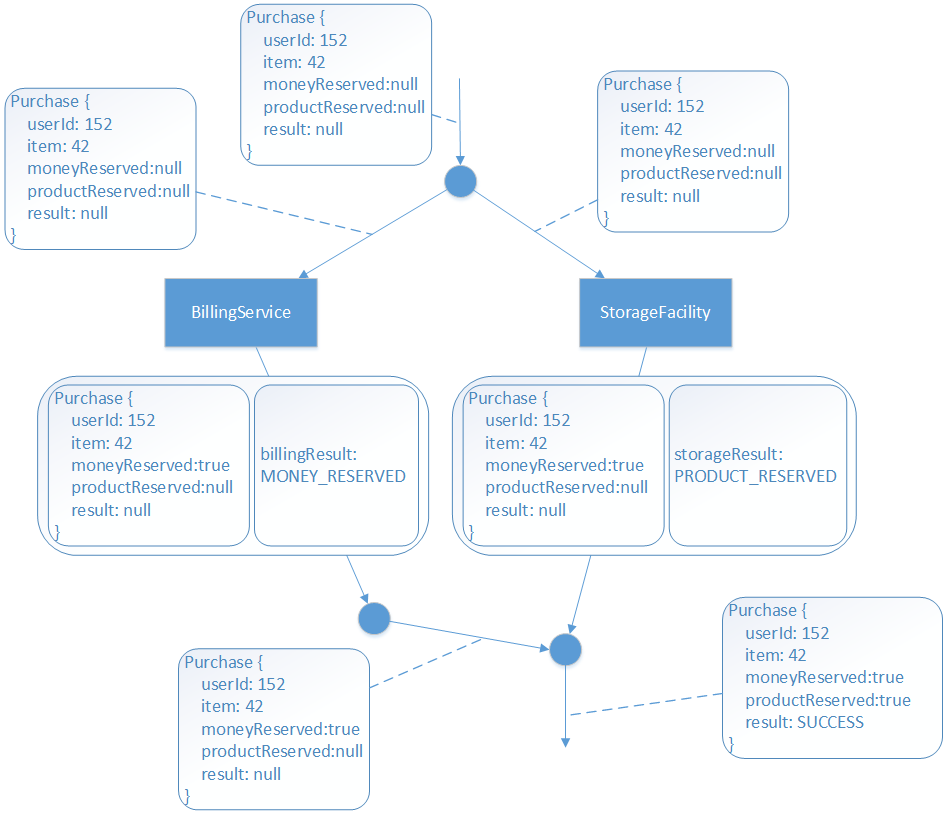 As a first step we create Purchase payload and populate userid and item. After that this payload first MergePoint
that does not modify payload but simply sends same Payload instance into two places in parallel: to BillingService
Processor and StorageFacility Processor. StorageFacility runs reservation logic and send via outgoing transitions two
objects: origin Purchase payload and product reservation status. BillingService runs reservation logic and send via
outgoing transition two objects: origin Purchase payload and money reservation status.
As a first step we create Purchase payload and populate userid and item. After that this payload first MergePoint
that does not modify payload but simply sends same Payload instance into two places in parallel: to BillingService
Processor and StorageFacility Processor. StorageFacility runs reservation logic and send via outgoing transitions two
objects: origin Purchase payload and product reservation status. BillingService runs reservation logic and send via
outgoing transition two objects: origin Purchase payload and money reservation status.
Left MergePoint that belongs to BillingService Processor waits for BillingService to complete. Then MergePoint takes
money reservation status and puts in into Purchase payload (by using it's merger function) and sends this Payload
through outgoing transition to MergePoint on right side of the graph.
//BillingService MergePoint merger
void merge(Purchase paylaod, BillingServiceStatus billingStatus){
if(billingStatus == MONEY_RESERVED){
paylaod.setMoneyReserved(true);
}
}Right MergePoint that belongs to StorageFacility Processor waits two incoming transitions: with StorageFacility
result and with Payload from BillingService. Then it takes StorageFacility product reservation status and puts it into
Payload that came from BillingService processor. This payload already contains information about BillingService
operation status. After that MergePoint checks both fields: Purchase.moneyReserved and Purchase.productReserved.
If both fields are true, MergePoint sets Purchase.result to true. This means that purchase accomplished
successfully. This process is done by using merge function of StorageFacility MergePoint.
//StorageFacility MergePoint merger
void merge(Purchase paylaod, StorageFacilityStatus storageStatus){
if(storageStatus == PRODUCT_RESERVED){
paylaod.setProductReserved(true);
}
if(paylaod.getMoneyReserved() && payload.getProductReserved()){
payload.setResult(true);
}
}Then StorageFacility MergePoint sends Payload with BillingService and StorageFacility results through outgoing transition at the end of the given graph.
Now we can simplify visualisation:
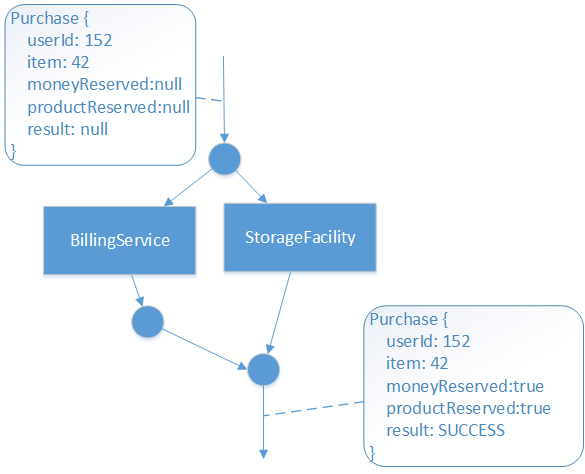
We almost thee. Fasten seat belts. Lets enrich our MergePoint with last feature: conditional transitions:
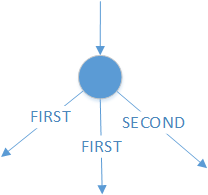
Each outgoing transitions now have enum value associated with it. In graph this enum value illustrated as text label
near arrow.
Merger function signature is changed too. Now merger should return enum that will control which outgoing transition
will be activated and which is not.
Enum merge(Payload payload, HandlerResult handlerResult) {...}When MergePoint is activated by incoming transition it evaluates merger function and checks merger result status.
After that MergePoint deactivates all outgoing transitions which associated enum values does not match the one
returned by merger function. After that MergePoint activates all outgoing transitions which associated enum values
matches enum value returned by merger function.
If there are two or more outgoing transitions that matches enum function result then all of them activates and runs
in parallel.
In given illustration we can control by which way execution flow goes by returning enum value FIRST or SECOND from
merger function of the MergePoint.
It is essential to read Concept paragraph to better understanding CompletableReactor model.
Payload is a plain old java object that encapsulate request, response and intermediate computation data required for request processing. CompletableReactor receive payload as an argument. Execute business flows, modify payload during execution and returns it as a computation result.
class Purchase{
//request parameters
Long userId;
Long productId;
//intermediate data
Boolean moneyReservationStatus;
Boolean productReservationStatus;
//execution results
Boolean purchaseStatus;
}Execution<Purchase> execution = completableReactor.submit(
new Purchase()
.setUserId(107)
.setProductId(42));
Purchase purchase = execution.getResultFuture().get();
System.out.print( purchase.getPurchaseStatus() );Start point of each graph represented by graphs Paylaod:
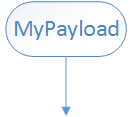
Handler is an asynchronous function that takes information from Payload and returns computation result. Handler implements atomic business logic of the execution flow. It could be reused in different flows several time. Handler MUST NOT change Payload because same instance of Payload passed to other handlers in parallel. Is is ok to concurrently read payload from several handlers but not to modify payload. The only point of payload modification is MergePoint.
@Reactored("myNiceHandler documentation")
CompletableFuture<HanlderResultType> myNiceHandler(String arg1, int arg2)` Processor is a visual graph item that represent a handler invocation. Processor encapsulates coupled business logic that usually can be reused. Processors graph item could be reused between different business scenarios in different business flows.
@Reactored("MyNiceService description")
class MyNiceService {
//...
@Reactored("myNiceHandler documentation")
CompletableFuture<HanlderResultType> myNiceHandler(String arg1, int arg2) {/*...*/}
//...
}Merger is a synchronous function that takes Handlers computation result and uses it to update Payload. It is safe to modify payload within merger.
@Reactored("myNiceMerger documentation")
Enum myNiceMerger(Paylaod paylaod, HanlderResultType handlerResult){
paylaod.getResponse().setData(handlerResult.getData());
return MyTransition.OK;
}MergePoint is a visual graph item that uses Merger method to make modification on Payload. And uses Merger result to select which outgoing transitions to activate and which to deactivate.
Transition is a Enum instance that represent jumps between graph items during flow execution. MergePoint merger returns instance of Enum. Outgoing transition will be activated according to this value. If merger returns status PLAN_B, then all outgoing transitions with condition status PLAN_B will be activated and all transitions without PLAN_B status will be deactivated or marked as dead transition. For unconditional transitions (onAny) there is no distinct status. That transitions will be always activated regardless of the merger result.
enum MyTransitions{
@Reactored("OneWay transition description")
ONE_WAY,
@Reactored("AnotherWay transition description")
ANOTHER_WAY
}EndPoint is a visual graph item that indicates end of flow execution. When graph execution reaches EndPoint then all transitions marked as terminated and CompletableReactor immediately returns graph result. The only exception is detached processors or subgraphs. They will continue to execute but their execution result will be ignored.
Processor uses Handler to make asynchronous computation, MergePoint uses Merger to apply Handler computation result on Payload. Origin payload is passed to Processors handler, then after handler computation origin payload is passed together with handler result to merge point. Inside merge point origin payload is modified and became Payload*. Outgoing transitions from merge point pass this new Payload* to next nodes.
If all of outgoing transitions from MergePoint have distinct statuses then flow will continue to execute only by one of transitions.
If MergePoint merger will return FAIL status then execution completes immediately. In case of FIRST status flow will continue and Processor2 will be invoked. In case of SECOND status - Processor3 In given example there could be three options:
- Payload -> Processor1 -> End (if merger returns FAIL status)
- Payload -> Processor1 -> Processor2 -> End (if merger returns FIRST status)
- Payload -> Processor1 -> Processor3 -> End (if merger returns SECOND status)
First payload goes to Processor1 and passed to Processor1 handler. Then framework waits when CompletableFuture
returned by Processor1 handler completes. After that MergePoint merger will be invoked and Payload with Processor1
handler result will be passed to this merger.
Merger will check Processor1 handler result, modify Payload if needed and returns one of statuses: FAIL, FIRST,
SECOND. After that execution will continue along with one of transitions:
FAIL leads to END, FIRST - to Processor1, SECOND - to Processor3.
If two transitions have same condition Status then flow will continue execution in parallel and both transitions will be activated.
In given example there could be two options:
- Payload -> Processor1 -> End (if merger returns FAIL status)
- Payload -> Processor2, Processor3 -> End (if merger returns OK status)
CompletableReactor will way until result of Processor1 is ready. The it send Processor1 result to MergePoint. MergePoint analyzes
Processor1 result, mutates Payload instance if needed and then returns merge status. If this status is END then flow execution stops. If
this status is OK then framework launches Processor2 and Processor3 in parallel.
MergePoint of Processor2 have two incoming transitions. It will wait until all of them is complete and only then will launch merger.
Suppose Processor2 will finish first. MergePoint of Processor2 will have to wait to second incoming transition from MergePoint of
Processor3. When Processor3 result is complete, MergePoint of Processor3 will be executed. If MergePoint of Processor3 returns FAIL then
all flow stops. If MergePoint of Processor3 returns OK then transition from Processor3 MergePoint to Processor2 MergePoint activates.
Then MergePoint of Processor2 executed. This will leads us to deterministic order of Payload modification and Processors execution.
Until now we pass by reference Payload instances to Processors. But some times we are not interesting in computation result of processor. It could be NotificationService that will send message to external system and current business flow is not dependent on notification result. We can not simply pass Payload to Processor6 by reference due to concurrent reading data by Processor6 and data modification in one of MergePoints. Problem could be solved by passing copy of Payload to Processor6 or by using Immutable arguments in Processor6.
Some times we want to launch Processor execution in parallel with main flow. In that case we have to pass copy of Payload to Processor6 or use immutable arguments to prevent concurrent reading by Processor6 and modification by MergePoints like in Detached Processor without MergePoint scenario. We have to use MergePoint to bring Processor6 result back to main flow.
Subgraph - is a Processor that execute Payload inside CompletableReactor. It have implicit Handler that takes Payload as argument and returns Payload as computation result. Subgraphs allows to reuse graphs.
Processors MergePoint receives Processors computation Result and reference to Payload passed to Processor. If there are incoming transitions to Processors MergePoint then MergePoint also receives Payload instances through this transitions. Detached MergePoint does not have transition from Processor with Processors Result. It have only incoming transitions. Both Processors MergePoint and Detached Merge Point uses same rules to chose Payload for merging.
- If there is single incoming transition (from Processor or other MergePoint) then Payload of this transitions will be used.
- If there are incoming transition from Processor and incoming transition from other MergePoint then Payload of Processors transitions will be used.
- Case when there is no Processors transition and more than one incoming transition is not allowed.
- Case when there is more that one Processors transition is not allowed.
During ReactorGraph building process CompletableReactorBuilder apply validation procedures on ReactorGraph instance. Validators checks that graph is consistent, have complete nodes and correct transitions etc.
https://plugins.jetbrains.com/plugin/9599-completable-reactor
Completable Reactor Intellij Idea plugin provides graph visualization and source code navigation within IDE.
You can jump to code using double click on graph item or context menu.
